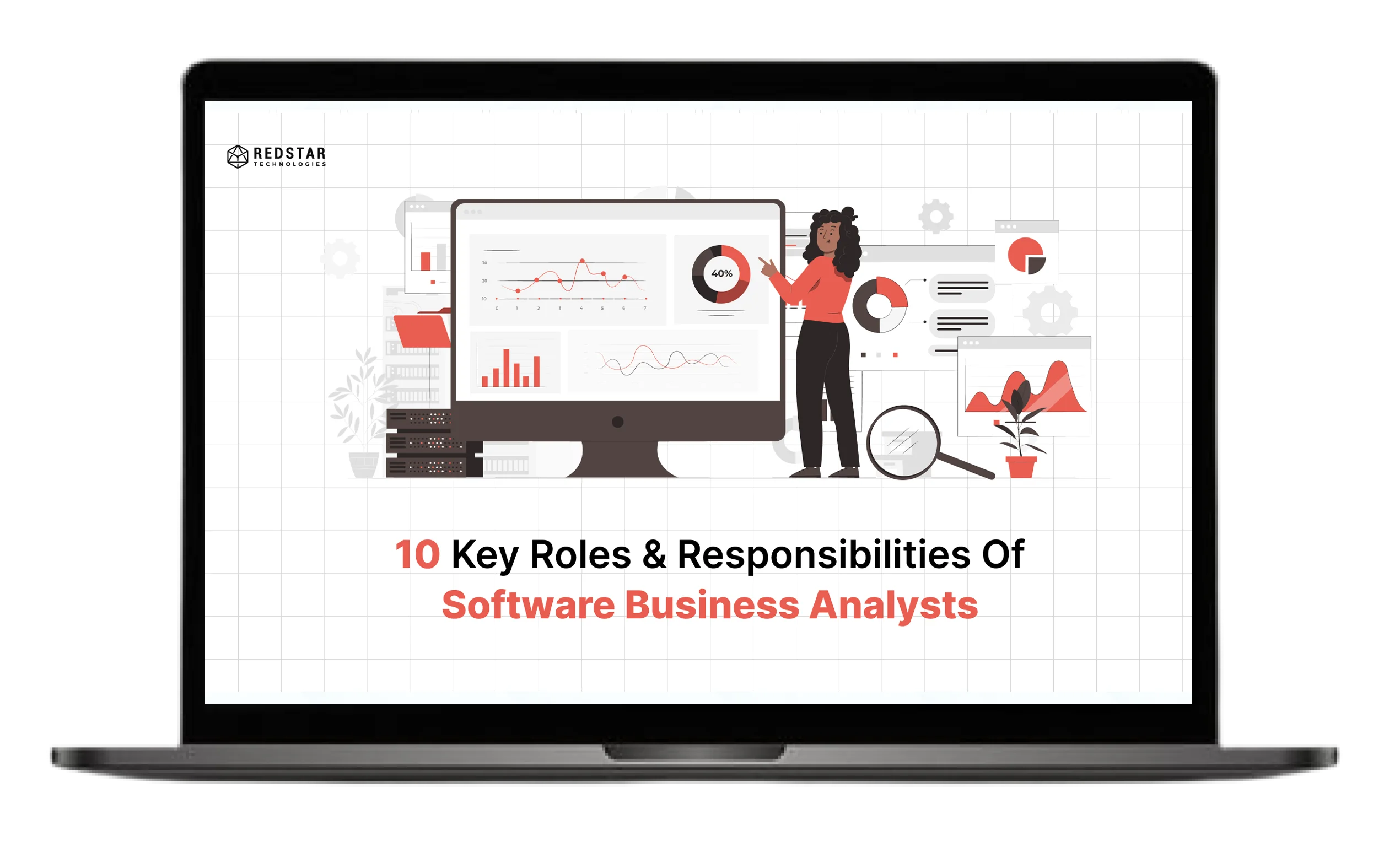
SRS or Requirement Analysis is often considered the most critical phase in the entire software development process. It serves as a road map to any project since the ideas are converted to distinct plans and strategies.
It assists business analysts in applying the right technique and eliminating errors that may hinder the success of the project in the future.
This blog focuses on the Top 11 Easy Strategies for Business Analysts to Manage the Requirements Ideally for Enhanced Project Outcomes.
Why are Business Analyst Techniques Important?
Here is why requirement analysis is helpful for businesses:

- Gain critical insights into a situation to capture possibilities.
- Stakeholders require solutions that offer ways in which decisions can be made.
- Minimizing costs, controlling risks, and making efficient use of the available resources.
- Avoid time wastage and obstacles in a project.
- Increase business productivity and the value of individual projects.
- Progress the product demand and check their market relevance.
- Meet project delivery timelines.
- Help support organizations more effectively strategize with goals in mind.
- Encourage innovation based on the analysis of the collected data.
11 Effective Business Analyst Techniques
Below are the 11 highly effective techniques to conduct a successful business analysis:
1. Business Process Modeling
In the case of BPM (Business Process Management), this tool is applied during the analysis phase of the project to determine the difference between existing business processes and planned processes. This method includes four main tasks:
- Strategic planning
- Business model analysis
- Process definition and design
- Technical analysis for complex business solutions
2. Brainstorming
Brainstorming is an effective and unchanging method that helps to generate ideas, determine the cause of the problem, and search for ways to solve it in a company. It ensures that all the teams are free to communicate and share various ideas about a particular project.
At times, brainstorming processes are combined with other methods such as PESTLE or SWOT analysis.
3. CATWOE
CATWOE is a conceptual framework that a business analyst navigates to combine various viewpoints into a single map. As a tool of analysis, it assists in defining the major stakeholders, supporters, and society as a whole to the proposed activities.
This approach ensures a well-rounded evaluation of potential solutions. The acronym stands for:
- Customers: Individuals or groups who benefit from the business or proposed solution.
- Actors: People or entities actively involved in the process or system.
- Transformation Process: The core change or transformation occurring within the system.
- World View: The broader perspective that influences how the system is perceived and its implications.
- Owner: The individual or organization responsible for the system and its outcomes.
- Environmental Constraints: External factors or limitations that may affect the solution or its implementation.
4. MoSCoW (Must, Should, Could, Would) Method
MoSCoW is more of a relative scale of comparison since it compares requirements against each other. It questions what needs to be found out what comes first and what comes second. This allocation of various tasks ensures that the most important tasks are given the topmost priority. This prioritization of various tasks ensures that the most important tasks are handled first.
5. MOST (Mission, Objectives, Strategies, Tactics) Analysis
MOST is highly effective in the assessment and analysis of the mission and capacity of an organisation. It includes identifying the goals of the organization and how best they can be met. The acronym stands for:
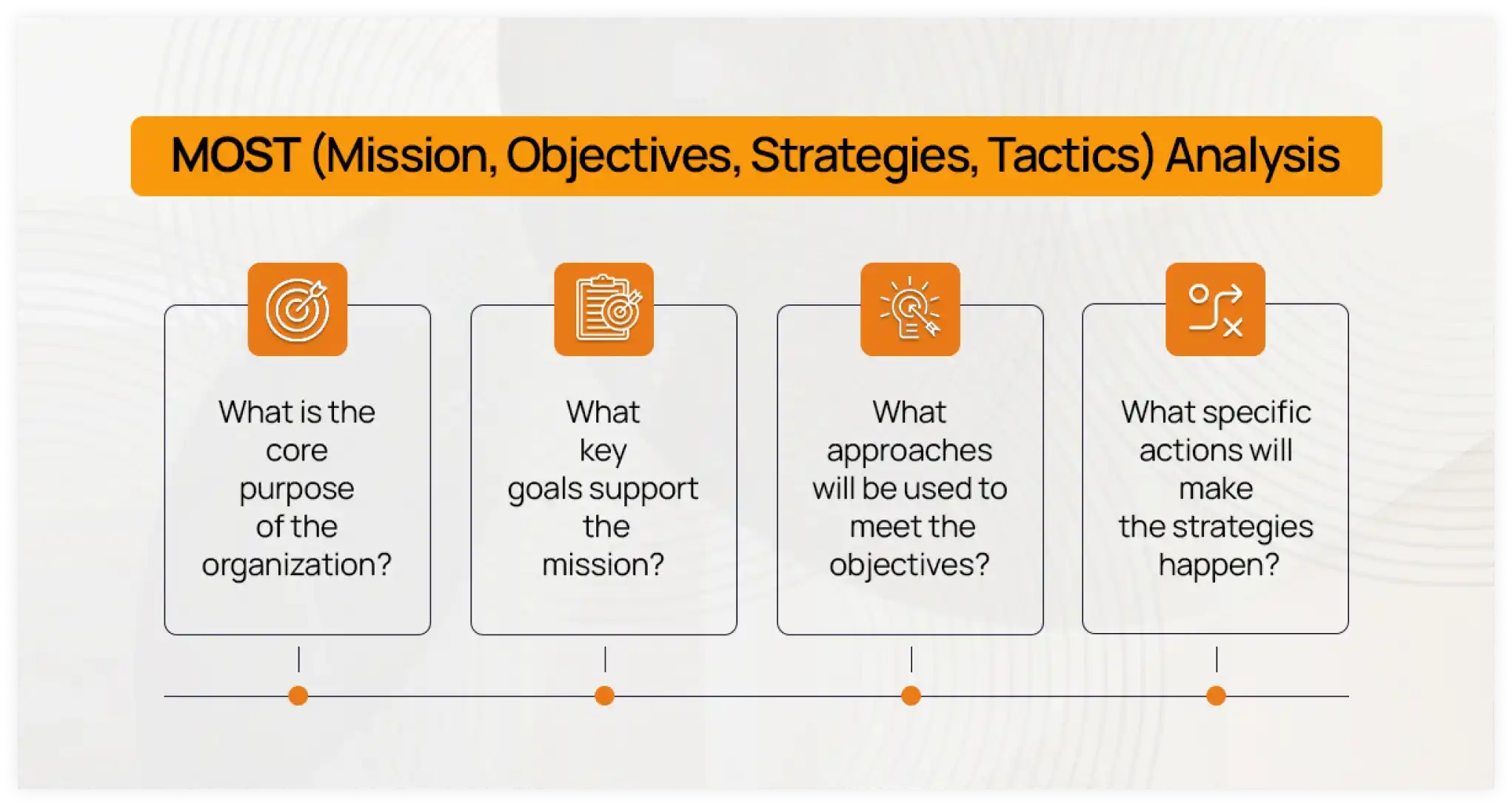
- Mission: What is the core purpose of the organization?
- Objectives: What key goals support the mission?
- Strategies: What approaches will be used to meet the objectives?
- Tactics: What specific actions will make the strategies happen?
6. PESTLE Analysis
Business analysts use PESTLE (also called PEST) to identify external factors that might affect the organization. These factors include:
- Political: Government policies, regulations, and subsidies.
- Economic: Labor costs, inflation, interest rates, and energy prices.
- Sociological: Education, culture, demographics, and lifestyle.
- Technological: Advances in technology and communication.
- Legal: Local and national laws and compliance.
- Environmental: Environmental regulations, waste management, and weather conditions.
7. SWOT Analysis
SWOT stands for Strengths, Weaknesses, Opportunities, and Threats, widely used to identify an organization’s strategic position.
This is because it provides business analysts with factual information concerning the internal environment and the rate of change in the external environment so that proper decisions about resource allocation can be made. The four components of SWOT are:
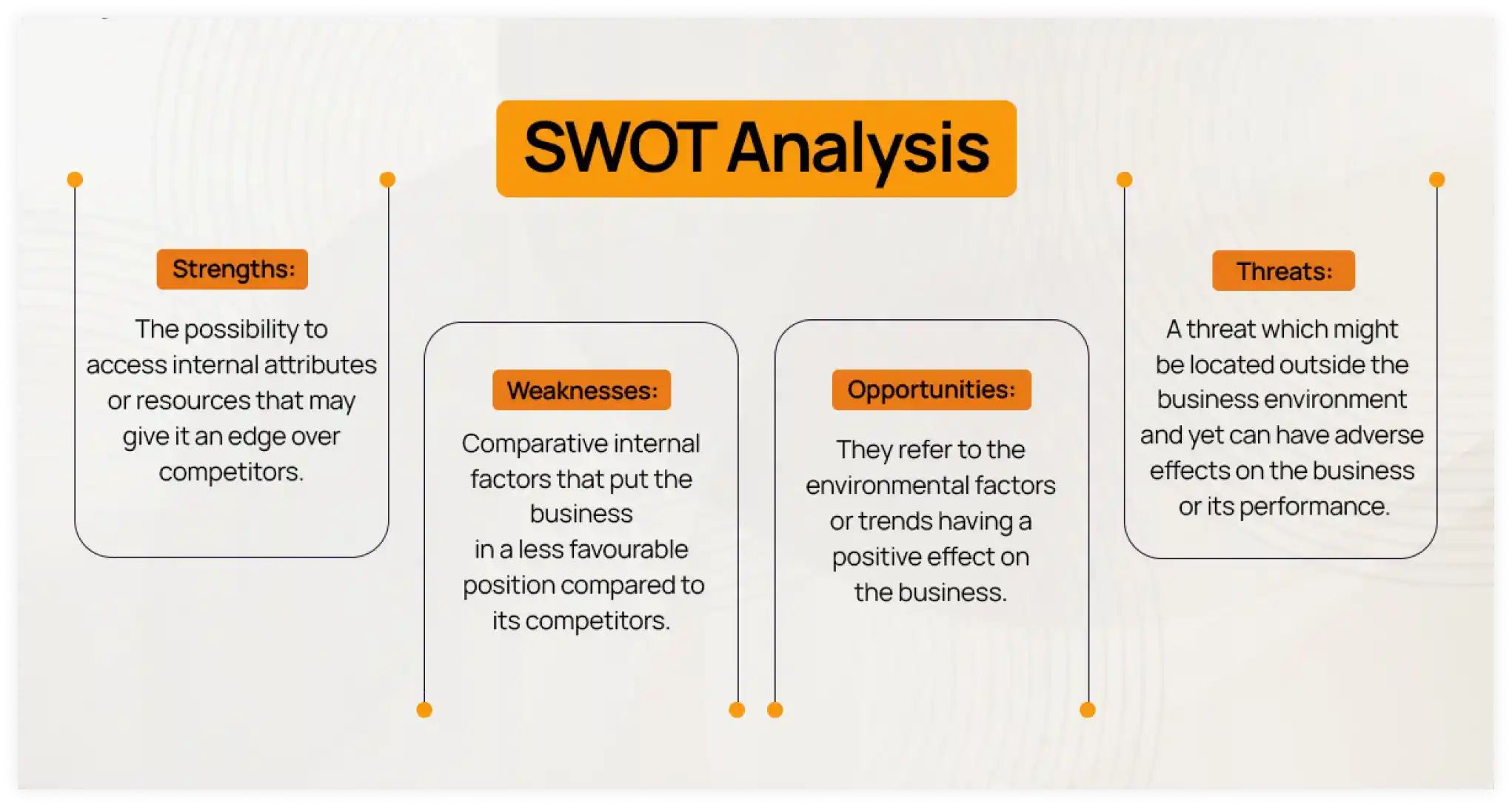
- Strengths: The possibility to access internal attributes or resources that may give it an edge over competitors.
- Weaknesses: Comparative internal factors that put the business in a less favourable position compared to its competitors.
- Opportunities: They refer to the environmental factors or trends having a positive effect on the business.
- Threats: A threat which might be located outside the business environment and yet can have adverse effects on the business or its performance.
8. Six Thinking Hats
Six Thinking Hats is a method which allows a person and/or a group to navigate through thoughts in an efficient and structured manner.
Every “hat” is an idea that challenges participants to analyze an issue through different perspectives. The six hats are:
Applicable in Six Sigma and business analysis, this technique consists of asking ‘Why’ five times to get to the bottom of a problem. The six hats are:
- White Hat: White hat represents the focus on the data, facts, and logical analysis
- Red Hat: Red hat incorporates intuition, emotions, and gut feelings.
- Black Hat: The black hat symbolically represents the considered potential risks and negative outcomes.
- Yellow Hat: Yellow Hat represents the positive aspects and encourages optimism.
- Green Hat: Green hat stimulates creativity and innovative ideas.
- Blue Hat: Blue hat oversees the overall process and ensures focus.
9. The 5 Whys
The 5 Whys technique is often used in Six Sigma and business analysis to uncover the root cause of a problem through a series of investigative questions. Here's an example:
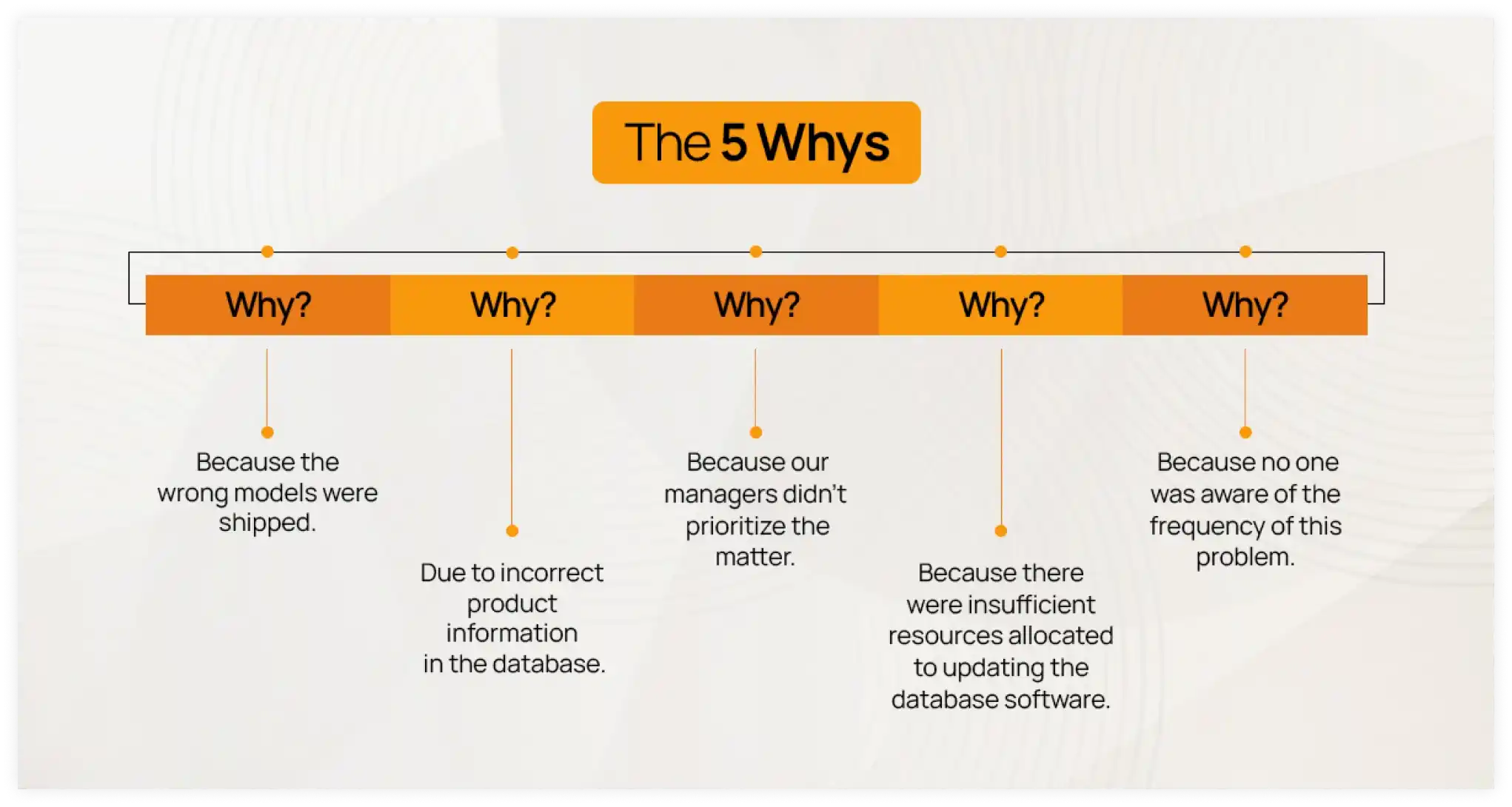
Problem: The client is refusing to accept delivery of certain 3D printers.
- Why? Because the wrong models were shipped.
- Why? Due to incorrect product information in the database.
- Why? Because there were insufficient resources allocated to updating the database software.
- Why? Because our managers didn’t prioritize the matter.
- Why? Because no one was aware of the frequency of this problem.
Solutions:
- Improve incident reporting procedures
- Ensure the managers review reports
- Allocate a budget for updating the database software.
10. Mind Mapping
Mind mapping is a powerful tool often used by business analysts in brainstorming sessions. It helps with idea generation, root cause analysis, and identifying requirements with stakeholders.
To create a mind map, follow these steps:
- Start with the main issue or organizational structure at the center.
- Branch out from the center to represent primary components, labeling each branch with relevant areas or issues.
- Use concise phrases to identify key components.
- Add second-level branches to break down complex components.
- Expand further with additional branches for more detailed information as needed.
11. Non-Functional Requirement Analysis
Non-functional requirement analysis is one of the techniques that a business analyst uses in a project that involves technological replacement, modification, or development.
This process revolves around identifying and describing the characteristics that a system must implement, including data storage, performance, and other aspects.
Non-functional requirements typically include:
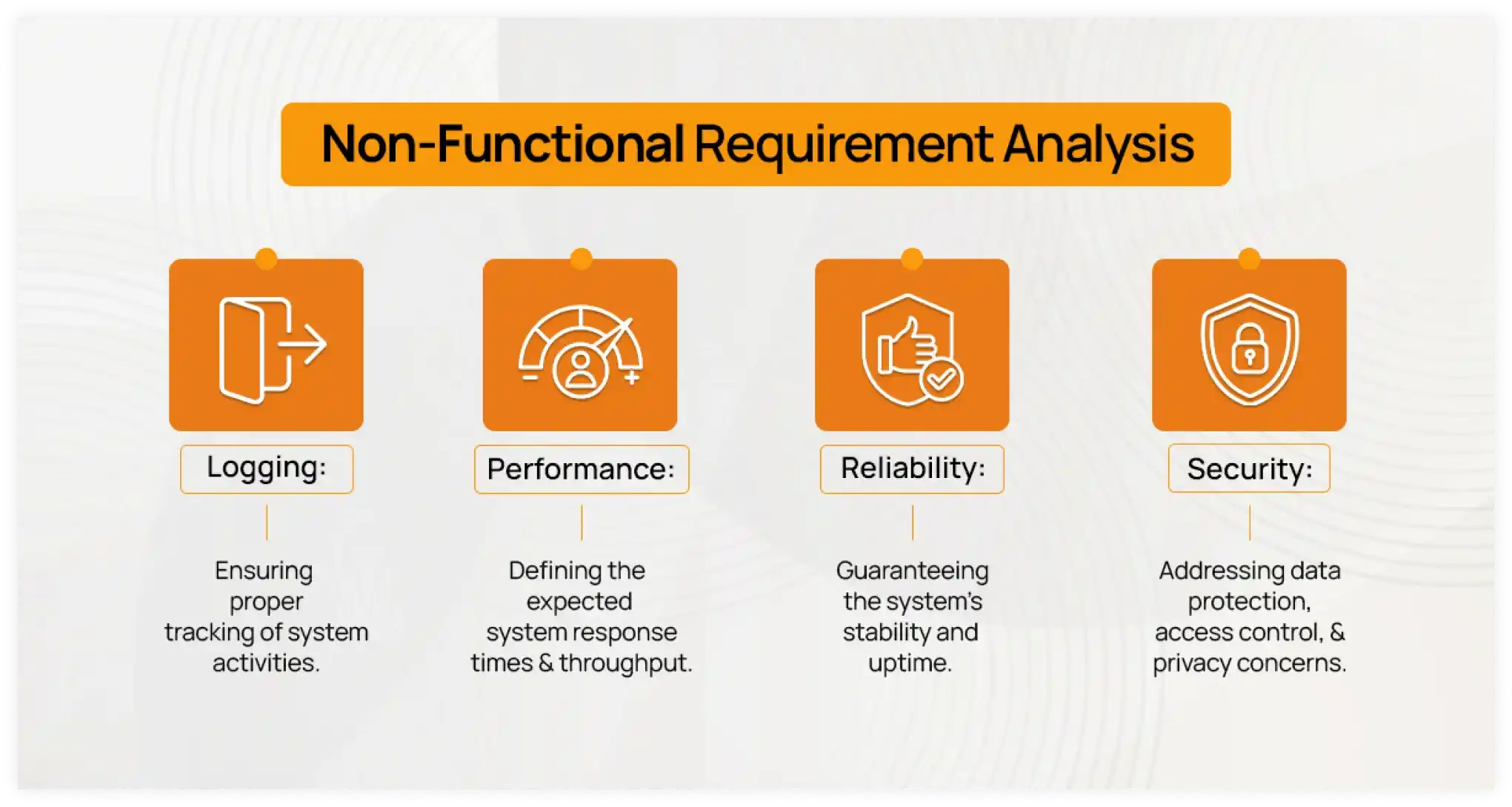
- Logging: Ensuring proper tracking of system activities.
- Performance: Defining the expected system response times and throughput.
- Reliability: Guaranteeing the system’s stability and uptime.
- Security: Addressing data protection, access control, and privacy concerns.
Frequently Asked Questions
1. How many techniques are there in BA?
The number of BA techniques can be more or less, and it depends on a particular project and business environment. The four common ones are SWOT, PESTLE, BPM, and the 5 Whys.
2. How to do requirement analysis as a business analyst?
To do requirement analysis:
- Collect data from the stakeholders either personally by administering an interview or filling questionnaire.
- List down their requirements and sort them according to the priorities set for business.
- Review all the collected data and ensure the stakeholders appreciate the requirements.
- Keep communication open to clarify any doubts and adjust as needed.
3. What makes a good business analyst?
A good business analyst must have good communication skills and should be a gentle listener to the stakeholders’ needs. They are very organized and can simplify abstract data into comprehensible ideas. They are also skilled at documenting and prioritizing requirements.
4. What is FRD in business analysis?
FRD or Functional Requirements Document is a documented report about how the particular system or project should work to satisfy business requirements. It describes specific features, behaviours, and actions the system must perform.
Conclusion
Problem-solving in any project requires business analysis techniques for one to understand what the issue is. The requirement analysis techniques are useful in helping software business analysts come up with correct decisions, enhance their functioning and obtain their objectives.
Structuring and the proper application of these techniques will save precious time, minimize unwanted risks, and maximize the project results. Once these techniques have been learnt, business analysts can then effectively deliver value and success to organizations.










